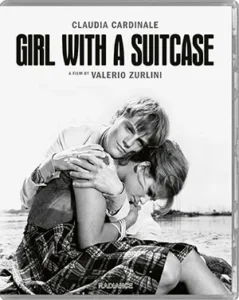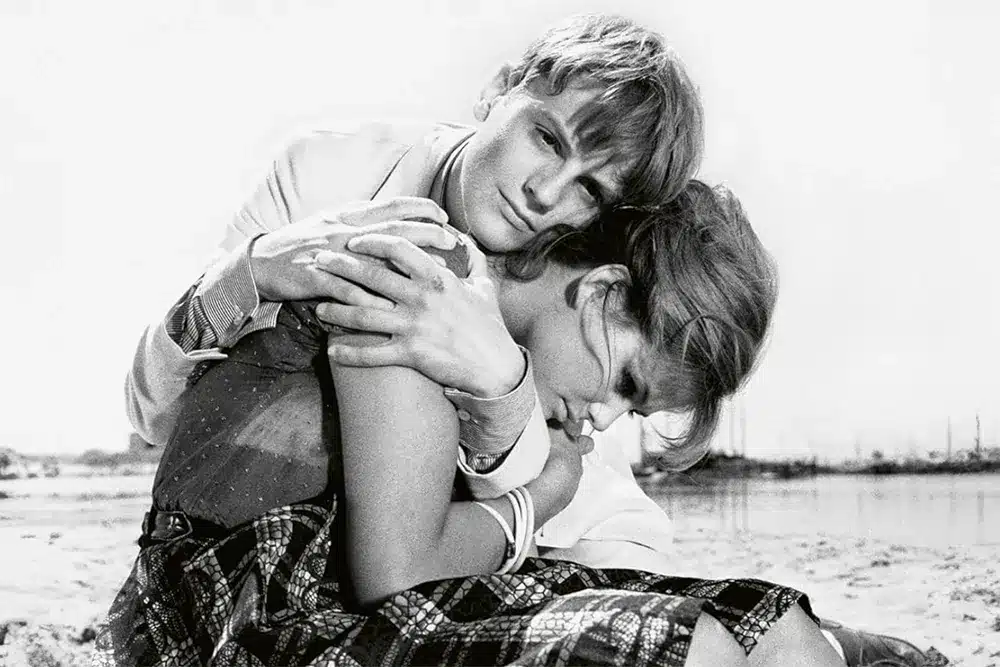
An alternately somber and charming title in the canon of Italian cinema, Girl With a Suitcase is a feature with the elemental afterglow of the film noir and Neorealismo styles and movements that had passed on by a few years by the time Valerio Zurlini’s film appeared in 1961. This drama, at times, pitches wildly between these two designs, entrapped by the realist constructions that tell a story of down-and-out youths on the brink of adulthood before the devices of noir free it.
In lesser hands, the tonal shifts might only serve to jar the narrative. However, Zurlini manages a disciplined balance that turns Girl With a Suitcase into a cohesive work, exploiting styles to deliver a truly emotional and sincere portrait of socio-economic clashes.
Stranded in a car garage by her selfish boyfriend, Piero (Gian Maria Volonté), Aida (Claudia Cardinale) endeavors to find his whereabouts and eventually tracks him down at his home. Piero, anticipating Aida’s arrival, ducks out of the household before she can confront him.
Once she arrives, Aida is greeted by Piero’s younger and very impressionable brother, Lorenzo (Jacques Perrin). Lorenzo is immediately taken with Aida, but he’s been instructed by Piero to tell Aida that she has the wrong address. Aida, unconvinced, nevertheless leaves Lorenzo the address of the hotel where she is staying.
The next day, a smitten Lorenzo visits her at the hotel, and a curious friendship is formed. Lorenzo invites Aida to come back to his house to stay, and Aida is suddenly privileged with the wealth her new friend possesses. Lorenzo’s hopes of earning Aida’s affections intensify, and together the two navigate a short, difficult, and bittersweet relationship. When it is revealed that Aida is, in fact, a mother on the skids with a young child, Lorenzo is thrown off guard and must soon regain his bearings.
Girl With a Suitcase is essentially a character-driven film with no discernible plot. Yet Zurlini produces in his leads two fine and magnetic people who draw attention to the screen through earnest and very natural performances. Cardinale, in particular, is a bold, fresh-talking charmer who evinces the doldrums of her predicaments with an easy but always sincere delivery of emotion and gesture.
Providing the counterpoint to this tension, Perrin manages an affably shy, tender-hearted, but always quick-witted Lorenzo. Together, in banter, quips, and flirtatious exchange, their dialogues sparkle; they create, in these characters, an amiable team, transferring a convivial, if not altogether sultry, energy between one another.
Lorenzo’s naïvety and Aida’s world-weary temperament produce, in the marbled and polished furnishings of their bourgeoisie surroundings, a friction that excites a new drama at every quarter-mark. There are comic moments to be found in Girl With a Suitcase, as well, and they are effortlessly earned; inadequacies generated by the class divide, as a politically judicious script sees it, are vigorously tested by a series of both gentry and proletariat conditions, providing plenty of instances of sobering humor.
Despite what appears to be a probing examination of the socioeconomics of the European class system, the film’s pleasures are simple. No need for big talk or deep, heavy thoughts – just the plain happenings of two lives being lived before the camera’s eye. Girl With a Suitcase is, possibly, the gentlest of love stories in European cinema, but one thickened with a warm soul and made richer by its heavy heart. The story’s atmospheres sweeten considerably before the bitter miasma of unrequited love taints the air.
Carefully and often sensuously shot, Zurlini’s film captures a lackadaisical Italy humming with the murmurs of everyday life; his camera, a percipient and always curious minder, captures bicycle rides through picturesque backstreets, or sunny walks during midday, between scenes of Romanesque statues in cathedral hollows and lonely, grey-sky beaches. It often pans like the sequences in an Alberto Moravia novel, the lives so stilled and framed with cinematic exactitude.
Zurlini also lends his story impetus through his unaffected handling of the action onscreen. So contentedly certain are we of the fate of these two hapless souls, Aida and Lorenzo, that the filmmaker’s much-foreseen dénouement can only appear as natural and satisfactory as everything that came before it.
Radiance’s Blu-ray release presents an excellent 4K transfer, rendering the picture in a gorgeously clear black-and-white remaster. True blacks and unspoiled whites temper beautifully all of the tonal greys that land in between. Of all the home versions of Girl With a Suitcase released thus far, this Blu-ray stands as its best representation. Sound and dialogue are clean and clear with no distortion. The film is in the Italian language with optional English subtitles.
As with all Radiance releases, Girl With a Suitcase comes with several supplements. Featured on the release are interviews with the assistant director, one of the screenwriters, and film critic Bruno Torri. Also included is a visual essay about the film’s eminence in Italian cinema. Rounding out the package is an informative essay booklet (available as a limited edition), written by Giuliana Minghelli and Cullen Gallagher. The Blu-ray also comes with a reversible sleeve, featuring both the original and new artwork. Region Coding for the disc is A, B, C: playable in both North American and European Blu-ray players.

